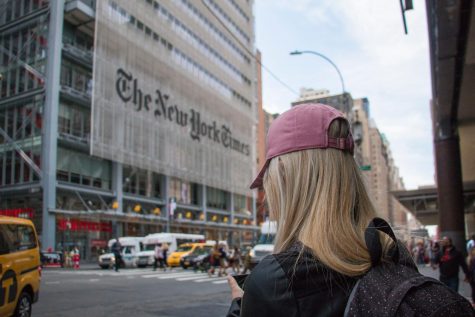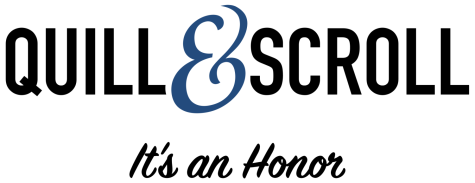THE WEEKLY SCROLL
September 4, 2020
News, tips and advice from Quill and Scroll
The Lede
Headlining change
Schools around the U.S. open amid challenge and change
Just one glance at the front page of the education news website Chalkbeat should provide any student journalist with ideas for at least a dozen stories.
- Colorado public health officials identify two new school outbreaks
- School opens in Philadelphia amid ‘Day of Action’
- Indiana education officials change school funding rules for virtual learning
- What COVID-era yearbooks will tell future generations
The ideas should start popping:
- Is our district keeping accurate numbers? How are they keeping track so that we know if there’s a school outbreak like the one in Colorado?
- If teachers in Philly are concerned about the cost of keeping their classrooms and their schools COVID-free, how much is your school or your district spending to make sure you’re safe? Where’s that money coming from if the U.S. Congress hasn’t passed the HEROES Act, designed to fund some of the safety measures?
- How does virtual learning affect school budgets, sure, but how much does a virtual environment also hamper student learning? What do researchers say about the value of an in-person learning environment versus a virtual one?
- And finally, how is your yearbook staff working to provide context for future generations who pick up your book?
That last one is super-important, and not just because of the pandemic. Black Lives Matters protests continue in cities and towns across the U.S. Politicians can’t seem to agree whether the protests are legitimate expressions of frustration over the systemic racism that drives police to shoot and sometimes kill persons of color, or if they’re simply lawless and violent outbreaks that need to be stopped by police and military force.
Oh, and the election. You know, for president, for U.S. senators and representatives, and for state and local offices around you.
There’s no shortage of stories.
Now get out there and find the truth!
How sports media is transitioning
In recent years, sports teams and media outlets have been criticized for commenting or reporting on racism outside of their industry. Think about the media coverage on Colin Kaepernick’s original kneeling controversy — his Google bio now lists him primarily as an American activist rather than a quarterback. Now, Kaepernick has signed a production deal with ESPN’s parent company Disney.
Times have sure changed.
ESPN continues to report extensively on collegiate and professional athletes’ participation in the Black Lives Matter movement. The NBA suspended three of five playoff games in a sign of protest of Jacob Blake’s shooting. With the empty air-time, ESPN analysts dedicated that time to discussing racial inequalities and injustice. In a similar manner, host of TNT’s “Inside the NBA” walked off set to show support for the players.
In an article for CNN Business, Kerry Flynn discusses the differences in our current sports AND political environment compared to attitudes and interactions in recent years.
“…amid a pandemic that forced sports to go dark and a national reckoning over race, sports journalists are learning that the firewall between sports and politics has vanished, if it ever existed,” Flynn said.
Multiple situations involving sports fans and players throughout the years can be labeled as political – but that didn’t always incite sports outlets to discuss the political of the issue. While this was in part a publication choice, sports fans also called for an absence of politics in sports media. According to a 2018 poll by ESPN, nearly, “85% of avid sports fans don’t want politics on ESPN.”
Yet, so much of sports IS politics. Jackie Robinson, Billie Jean King, Muhammed Ali, Robbie Rogers and so many more athletes have collided head first with issues that are inherently political.
Vaccine!?!?!?! When?
President promises pre-election immunizations; doctors say ‘hold on’
It’s An Honor
Q&S Fall Deadlines
Q&S Student Board applications due Sept. 8

Photo by Ian Stauffer on Unsplash
The Quill and Scroll Student Advisory Board is looking for several committed students to make a difference among their peers this year.
Formed two years ago, the SAB has a triple purpose:
- To plan and execute a nation-wide pro-journalism activity every year, possibly in coordination with another journalism association such as JEA.
- To provide counsel to Quill and Scroll chapters around the world about possible activities for their chapters.
- To provide counsel to the Quill and Scroll Executive Director and staff about the organization’s membership benefits, contests and other activities.
The activities should:
- Promote and embody at least one of the eight lights in the Quill and Scroll induction ceremony: Truth, Leadership, Loyalty, Initiative, Integrity, Judgment, Friendship and Learning.
- Bring together Quill and Scroll chapter members from across a school and across the world to work on a unified project.
- Reach out to the school and/or community from which a chapter draws its students.
- Have a broader impact in promoting the ideals of scholastic journalism, as they relate to the eight lights.
The student board members have the power to define exactly what those activities look like. Q&S student board members are not required to, but they may also contribute podcasts, columns and editorials to Quill and Scroll’s online magazine, The Digital Quill.
It’s a great way to practice leadership at an international level, and a great way to promote the principles of truth, leadership, learning, loyalty, integrity, initiative, judgment and friendship. Apply today. The application deadline is Sept. 8.
FREE Google Tools training from SPJ and Quill and Scroll
Sign up today to take part in a training provided free by Quill and Scroll in partnership with the Society of Professional Journalists. The training is set for 2 to 4 p.m. CT, Wednesday, Sept. 23.
Learn about all of the free Google tools that can help your newsroom build interactive charts, maps, visualizations and more. This is a hands-on workshop, so be sure to bring your laptop and smartphone.
Tools we’ll cover: Google Flourish, Google Dataset Search, Google Fact Check Explorer, Google Earth, MapChecking.com, Google Trends, MyMaps, Earth Engine Timelapse, data scraping with Google Sheets and more.
More information on SPJ Trainer Mike Reilley and the registration form is on this page.
It’s never too late to honor seniors and induct members
If you put off your spring celebrations, you can still induct new Quill and Scroll members and honor seniors this fall. We’re able to take and fulfill orders, even as Quill and Scroll staff work from both our home offices and our offices at the Adler Journalism Building on the University of Iowa campus.
We published this update earlier in August. It includes a simplified order form for schools and advisers willing to pay via credit card, and an offer to host an online induction ceremony for your students. The sooner you induct new members, the sooner they’ll be able start planning chapter activities in the spirit of Quill and Scroll. Here’s a link to a PDF file of the Q&S Chapter Handbook if you don’t already have it.
A reminder about cords:
Students MUST HAVE BEEN OR WILL BE INDUCTED into the Society to earn the honor to wear an Honor Cord (GHC) or Honor Cord with Insignia (GCI). If you order cords for non-members, please choose the Non-Member Cord Option (NCD). Quill and Scroll exists because of the special unifying bond brought about by membership and the lasting legacy of the induction ceremony.
And, as always, feel free to email [email protected] if you have any questions.
Yearbook Contest
The Yearbook Excellence Contest deadline is Oct. 10 for all 2020 books. Students may enter their work in 18 categories, and all individual entries are $5. Theme Development entries are $10. There’s no limit on the number of individual entries a school may complete. Each school is limited to one Theme Development entry.
Competition is divided by school size, with Class A consisting of schools with 750 students or more, and Class B consisting of schools with 749 students or fewer. Begin your entry process here.
News Media Evaluation
News Media Evaluation judges are wrapping up their work this month, and we should be able to announce our Gallup Award winners by mid-September at the latest. Stay tuned to The Weekly Scroll by subscribing here.
What’s Hot?
Time for more news

Photo by Sara Groblechner on Unsplash
NY Times launches free access to high school students and teachers
The New York Times announced a partnership with Verizon that will provide students and teachers with free access to all of their online content until Sept. 1, 2021. Here’s how you can get access:
- Your high school administrator/teacher registers your school
- They enter valid student names and email addresses
- You receive an email invitation to sign in and access The New York Times online
It’s that simple! You will then have free access to all Times content until September 1, 2021.
The “Karen” effect
Viral sensations point fingers at temper tantrums in middle-aged women: but what are we really doing?
I’ve been using the term “Karen” for years. From describing an over-involved soccer mom to a demanding retail customer, the “Karen” figure existed long before TikTok made her famous.
The various tales of “Karen” float through social media with the ease of sharing a video: but here’s the kicker — who is thought to be “at fault” in these situations?
Your position as a social media user reflects the version of the encounter you see. The Atlantic contributor Kaitlyn Tiffany points out in her article, “America’s Summer of Viral Meltdowns,” people are waiting to repost and share these videos – but for what purpose? In the same article, Tiffany interviews University of Washington doctoral student of online toxicity Katherine Cross.
“The individualist logic of social media leads us to believe that we can virally shame our way to a better world,” Cross said.
Our ability to share content that appears, at its core, wrong, is comforting. In a world where we have so little control over everything else, we recognize the ability to “call out” what we believe to be wrong. Yet, if you were the “Karen” in said situation, your perspective would be drastically different than the viral videos Generation Z gets in their hands.
A little bit of perspective: what are we trying to prove with our Karen videos? Is it a cry to Karen’s everywhere to change their views, or is it a humiliation factor?
Britain focuses on edited content
Proposed bill could require celebrities to mark photos as edited

Photo by Amanda Vick on Unsplash
Tory member of Parliament Dr. Luke Evans proposed a bill this week that would require celebrities to state if an image has been digitally altered. The bill draws on the harmful expectations social media draws for children and young adults.
While no such bill has been proposed in the United States, there is countless research on the harmful effects of social media to young children. According to a 2018 study by the National Heart, Blood and Lung Institute nearly 40% of girls ages 9-10 were actively trying to lose weight.
In her article, “The Effects of Social Media on Body Image and Health,” Amanda Doria, contributor to the “Life Sciences” Journal of Boston College, said, “This is largely a consequence of how the media in general has painted a picture of the ‘ideal’ body type: tall, stick-thin women who have very few curves,” Doria said. “In reality, this physique is unrealistic and potentially unhealthy for the vast majority, but one that many young girls chase after, as demonstrated by the rising presence of eating disorders in women and the usage of photo editing apps to alter one’s body to his or her satisfaction.”
No headway has been made regarding the bill; however, if passed, social media will look very different in Britain.
The vampire effect
Stephanie Meyers’ “Midnight Sun” relaunches vampire craze
Do you remember the simple days when a classmate would come to school with two marks on their neck and shyly say, “I was bit by a vampire?” Well, those days are back – and affecting a whole new generation of readers.
Stephanie Meyers announced the release of her Twilight Saga prequel “Midnight Sun” in May. Once the book was released on August 4, it sold over one million copies in the US in one week. The novel takes a second look at “Twilight” – the first in the series – from Edward’s perspective. From Greek metaphors to Biblical references, “Midnight Sun” makes you cringe in all the right (or wrong) ways.
The staple success of Midnight Sun prompted Meyers to announce the appearance of at least two more books in the Twilight Saga at a virtual Books-a-Million’s event.
The last Twilight Saga novel, “Breaking Dawn,” was released in 2008; the two-part movie followed shortly in 2011 and 2012. The question is: will Robert Pattinson and Kristen Stewart reunite to make a “Midnight Sun” movie nearly a decade after their last performance?
my twilight phase coming back to get me #MidnightSun pic.twitter.com/rcKrHBG8lX
— hols ⁷ IN生 (@yllohlou) May 4, 2020
Can’t believe Stephanie Meyer is gonna save the summer with midnight sun pic.twitter.com/uPRJsN6a9P
— snufkin_with_knife.jpg (@mxmothman) May 4, 2020
Just A Thought
A word on the future of journalism
NME judges weigh in on what they learned from participating publications
We recently asked a handful of our News Media Evaluation judges to reflect on the journalistic work they evaluated that was often completed after COVID-19 entered our radar. Needless to say, they were impressed with the work student journalists throughout the country are able to create in a time of constant change. Here are a few of their thoughts:
“I’m always amazed at the caliber of journalism we see each year in these evaluations. While reading through the publications, I find myself making notes and getting ideas for my own newspaper. It’s great to see students working hard to report with accuracy and present ideas in different ways. The students did an excellent job of keeping readers informed through uncertain times of a pandemic. It’s exciting, as someone who first became interested in journalism in high school, to see enthusiasm for our chosen industry in a new generation.” – Annie Wooden, Editor and Publisher, The Sanders County Ledger (Montana)
“There is terrific journalism being produced all across the country, in large schools and small. There is a special kind of life and voice in the best writing and photography and multimedia coverage I saw while critiquing. The reporting wasn’t always perfect but any reader could sense dedication to the truth and a genuine love of community. The kids are alright. Programs that participated in NME are in the midst of a transition from print news to magazine journalism, and away from giving readers the same content on multiple platforms and instead considering each platform as having unique strengths. Short video segments, often edited on a phone, give readers another entry into our coverage. Top programs are exploring doing more with Instagram and forsaking ‘social media for parents and grandparents,’ like Facebook. Daily newspapers are not our model anymore for print, and committing to a magazine philosophy can be a fun challenge.” – Jack Kennedy, former executive director of Colorado Student Media Association
“Reading and critiquing these entries was invigorating. I was thoroughly impressed by the work being done in scholastic newsrooms across the country. Students are really pushing the envelope, tackling the important stories in creative ways. One surprising takeaway from this year’s entries is how much some schools are experimenting with digital. It was great to see publications offering podcasts and video series on their websites and meeting their audience where they are: on Tik Tok and Instagram.” – Erica Hernandez, CNN producer
“All of the publications I judged included information from the advisers about the schools and their programs. Some staffs had under 10 students. All of the programs had been interrupted in March when the pandemic closed schools. Yet, the newspaper, website and yearbook staffs continued to work under difficult circumstances. This was all new to the students, but they adjusted their programs so that the school community could still have information. I am impressed with the work I see as a judge from students and advisers. After being out of scholastic journalism for several years, I had not thought that this field would be so thriving. I think that student journalists will continue to acclimate, and they will amaze those who follow their work.” – Jackie Mink, retired journalism adviser
“What I was most impressed by in the work I judged for Quill & Scroll this summer was the high caliber of the students’ reporting skills, the professional mindset that underpinned their efforts, and the students’ ability to adapt to challenging situations, most notably how they discovered ways to report during school closures this spring during the pandemic. Students are developing the skills needed to report across multiple platforms, and their final products are impressive.” – Trevor Ivan, journalist and journalism adviser
